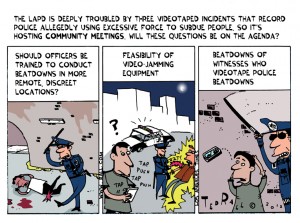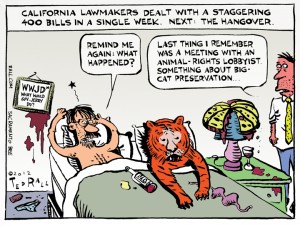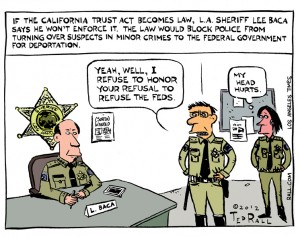Antiwarriors Are Citizens Without a Party
Americans overwhelmingly oppose the wars against Afghanistan and Iraq. Even many veterans say the post-9/11 war on terror was a mistake.
Antiwar sentiment is the majority opinion when it comes to the prospect of future conflicts. Of the two countries the U.S. is currently most likely to attack militarily, nearly seven out of ten people are against invading Syria; even polls that ask leading questions (“do you favor a military strike to prevent Iran from acquiring nuclear weapons?”) find public opinion running opposed to attacking Iran, by 52% to 41%.
Not only are most Americans against wars present and future, we want to slash defense spending in general. According to a National Journal poll, 60% want to cut the Pentagon budget. Thirty-five percent don’t.
Eleven years after America lost the Twin Towers and then its collective mind, something remarkable has happened. We’ve come to our senses.
We’re a nation of pacifists.
So how is a pacifist—in other words, an average American—supposed to vote this fall? Obviously not Republican: Romney says he’ll cut every department except Defense. He wants to spend more on weapons, is open to fighting against Afghanistan and Iraq indefinitely, and is so ignorant that he doesn’t know that the people of Afghanistan are called Afghans.
But with all the veteran and war messaging that went on at last week’s national convention, Democrats look like a mirror image of the GOP: jingoistic, militaristic, and gung-ho for war. Between pogo-dancing on Osama bin Laden’s corpse, the airing of a mawkish “Honoring the Sacred Trust with Our Veterans” video that spread the debunked right-wing myth that returning Vietnam vets got disrespected, the First Lady donning a Dubya-inspired “support our troops” T-shirt, and Democrats’ petty attack on Mitt Romney for omitting to name-check vets in his nomination acceptance address, it felt like the 2002-03 build-up to the invasion of Iraq—except, this time, the president speaks fluent English.
It’s official: the Dems are a war party.
Why the new bellicose tone? In part it’s an attempt to counter the old canard that Democrats are weak on defense, a charge that Republicans used to their electoral advantage throughout the Cold War. As the probably doped Lance Armstrong advised, turn your biggest weakness into your strongest strength. (The Machiavellian Karl Rove, who attacked John Kerry’s war record of all things, put it the other way around: turn their biggest strength into their biggest weakness.) It’s also a reflection of the triumph of Democratic Leadership Council-inspired conservatives, who have cowed, purged and marginalized liberals and pacifists from the party.
Militarism may be unpopular, but it still rules the ruling class. The military-industrial complex enjoys more direct political and economic influence among government officials than ever. The post-9/11 Cult of the Noble Soldier, coupled with the myth of a beleaguered U.S. defending the world from barbarians in an epic clash of civilizations, merely recasts old-fashioned fascist militarism—and it’s just as effective at confusing leftie opponents and putting them off-balance.
Truth be told, the Democrats’ new hawkish tone is catching up with their party’s hawkish history. Ronald Reagan gets credit for the defense build-up of the 1980s that supposedly bankrupted the Soviet Union, but it was Jimmy Carter who started it in 1978. No one remembers now, but “wimpy” Carter also gave us draft registration (in response to the Russian invasion of Afghanistan). Mr. Habitat for Humanity sent arms to the Afghan mujahedeen (some of whom formed Al Qaeda) and provoked the Iran hostage crisis by admitting the recently deposed Shah to the U.S. Bill Clinton launched an optional war of choice against Serbia based on sketchy justifications, and waged an incessant aerial bombing campaign against Iraq that went on so long that the media got bored and stopped covering it, and U.S. pilots ran out of targets.
President Obama may not have been popular with the SEAL team he sent to assassinate bin Laden, but thousands of Pakistanis, Afghans, Yemenis and Somalis victimized by the reign of terror unleashed by his unprecedented, expanded program of drone plane bombings can attest to his credentials as a happy warrior. “Barack Obama,” Aaron David Miller, Middle East policy adviser to Republican and Democratic administrations, wrote recently, “has become George W. Bush on steroids.”
Democrats have always been pro-war. They’d might as well shout it from the rooftops.
Most Americans are against the wars in Iraq and Afghanistan, the cult of militarism and the untouchable status of Pentagon spending on weapons. Yet there is no political home for people who oppose our current wars, or war in general.
Where is a pacifist to go?
(Ted Rall‘s new book is “The Book of Obama: How We Went From Hope and Change to the Age of Revolt.” His website is tedrall.com. This column originally appeared at NBCNews.com’s Lean Forward blog.)
COPYRIGHT 2012 TED RALL




